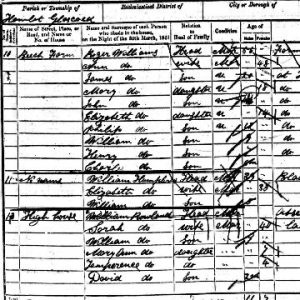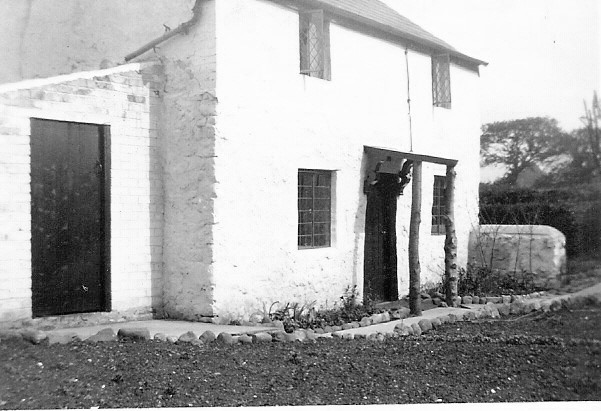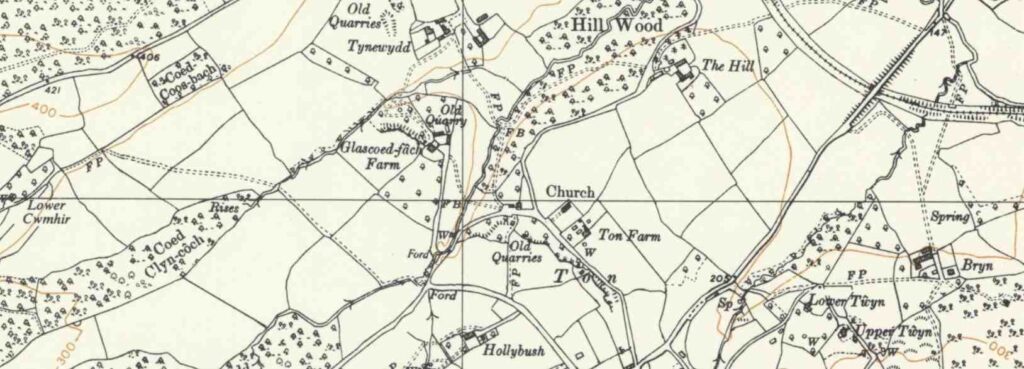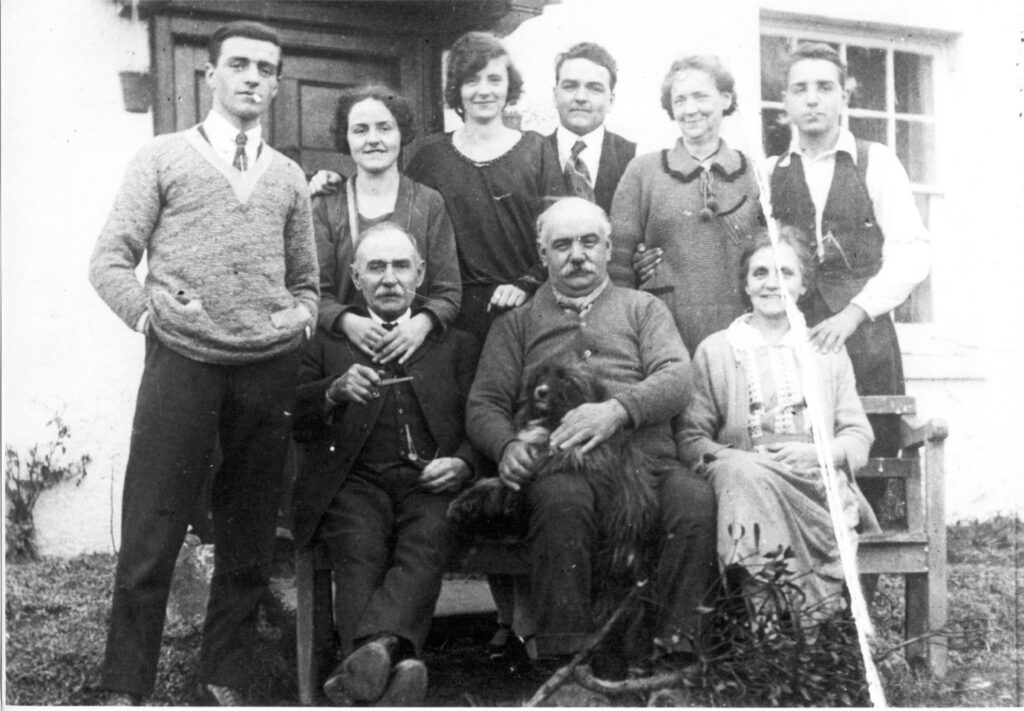
Hill Farm is a Grade II Listed building dating from the early 17th century – a similar period to some of the other farmhouses in the hamlet, such as Beech Farm.
The Coflein website (“The online catalogue of archaeology, buildings, industrial and maritime heritage in Wales”) describes Hill Farm as follows: “Description: House is an early C17 two cell house with a possible C18 wing and a refurbishment of the main block in the early C19. It has been little altered since except for a flimsy late C20 extension at the rear.” Apologies to the current occupants of Hill Farm – how rude for them to call your extension, “flimsy!”
As a listed building it has been included on the “British Listed Buildings” website. I have reproduced the description of the property below in full from the British Listed Buildings site and accept all of the conditions of their Creative Commons Attribution-Share Alike 2.0 UK: England & Wales License. The Sections reproduced are headed: History, Exterior, Interior and Reasons for Listing.
Facts and Figures

Year of Construction
Early 17th Century.

First Recorded Residents and year
William Morgan, in 1806 Land Tax Assessment.

Residents at time of the 1851 census
John and Mary Morgan, and Family
History
This house is an early C17 two cell house with a possible C18 rear wing and a refurbishment of the main block in the early C19. Early C21 extension to rear.’
Exterior
The house is rendered, presumably over local sandstone rubble which can be seen in the kitchen wing. Natural slate roof. The main elevation is in three bays with a distinct batter to the lower walls and a slight bell-cast to the roof; both are indicators of age. Central entrance with a six panel door with a timber segmental hood over. This is flanked by early C19 sashes with 8 over 8 panes; the upper floor has three smaller windows with 3 over 6 pane sashes. Plain roof with rubble stack at either end; the one on the right gable is C17. The right hand gable has a semi-circular bread oven added in place of the original entrance door. The left hand gable is blind. The rear elevation has early C21 extension. There is also an earlier, probably C18, block which houses the present kitchen, now connected with modern extension. This has plain windows, a plank door and a large brick stack.
Interior
The planning of the original block was changed in the early C19 when the central staircase was inserted. This is plain, enclosed on both sides, with an arched head to its entrance. The large living room fireplace has been re-opened, and has wooden beam; exposed bread oven. The rear kitchen has rough beam to ceiling, and now runs into extension with similar modern beams. The upper floor has three small rooms. The principal rafter roof is largely hidden.

Reasons for Listing
Included as a two period farmhouse of attractive appearance and character.
FACTS AND FIGURES
Year of Construction (Photo at end of document)
Estimated early 17th Century.
First recorded residents and year (Photo at end of document)
William Morgan – known to be there in 1806.
Residents at time of the 1851 census (Photo at end of document)
John and Mary Morgan.
Location

Hill Farm can be found as “The Hill” towards the top of this 1964 map, used with permission from the National Library of Scotland’s marvellous “Old Maps” section.
Residents
The Morgans (Early 1800s to the late 1870s)
The Morgans are the first family that I am aware of who lived at Hill Farm, although there were certainly earlier residents than them. The Morgan family were certainly the proprietors of Hill Farm from as early as 1806 until the late 1870s, initially via a Mr William Morgan (of Mamhilad) until at least 1829. By 1831 Mr John Morgan – in all likelihood, William’s son – was the farmer. John was succeeded by his son, another William Morgan following his death in 1864.
For some reason William left the farm between 1872 and 1874, although it continued to be part-owned by Arthur Morgan until at least 1879.
The Morgans were a well-respected and relatively prosperous family.
One of the daughters, Anne Elizabeth married a man who went on to become a reasonably well-known figure in the UK, Alexander Wynter Blyth. At the time of the marriage, he was a medical student at King’s College, London, and son of a GP. He went on to become one of the UK’s leading figures in the area of public health, medicine and science
Transitory tenants (1878 to 1881)
The next occupant of the farm was Thomas Crump, although he only stayed a few years. He was tenant in 1874 and appeared on the Register of Electors until 1876. There was no tenant listed on the Register in 1878. Edward Jenkins was the tenant briefly. He appeared on the 1879 register of electors, but was replaced before April 1881 by William Charles and family, according to the 1881 census. William, was aged 30 in 1881, and was born in Llanfrechfa Upper. His wife Elizabeth, was 6 years younger, and a native of Trevethin. They had a 3 month old daughter at the time of this census and two servants helping them with the farm and domestic duties.
The Powell family (1887 to the mid 1920s)
Edward Powell and his wife Sarah (nee Rees) were farming here by 1887, since their Thomas Charles Powell was born in Glascoed – he was aged 4 at the 1891 census. We also see Edward on the 1889 Register of Electors as the tenant at Hill Farm and also in 1909 and 1911. The final record I have seen with the Powells at the farm was the 1922 Register of Electors.
Edward and Sarah had at least 5 children (Phillip John, Sarah Jane, Edward Rees, Thomas Charles and William James – the last two were born at Glascoed).
Edward was from Llanthewy; he was born there in approx 1842 and his wife Sarah was from Nantyglo (born approx 1848). They had been living at Llanfrechfa Upper previously – certainly between 1875 and 1881, if the ages and places of birth of their children on the censuses are an indicator.
The Pegington family (Late 1920s? onwards)
William Henry Pegington farmed at Hill Farm from approximately 1928 to 1937. He had purchased the farm and was responsible for it until 1942 according to Land Tax records. The Pegington family were definitely in residence at the time of the 1939 National Register, on 29th September 1939.

Second World War
At the outbreak of World War II, they (the Pegingtons) were still at the Hill Farm and “Beat”, Bill’s wife used to tell the story of the underground shelter in the garden, where they sought refuge during an air-raid warning on the Royal Ordinance Factory, Glascoed, which the farm overlooked. They had rushed down to safety in their night-clothes, but didn’t stay long, because a big four inch slug started climbing up her leg. They never went down there again! On another occasion (on the 31st October 1940 according to official records) she claimed that the blast from a bomb dropped on the nearby ROF blew her from the doorway across the room. The German pilot later reported back to Germany that he had bombed Bristol, 40 miles away and was even given a medal for it! The Battle of Britain Campaign Diary records: – “The Royal Ordnance Factory at Glascoed was attacked by a single enemy aircraft at 1250 hours. The attacking aircraft dropped 12 bombs, three of which are still unexploded and then proceeded to machine-gun the factory from a height not greater than 200 feet. The roof of the building was damaged and whilst the unexploded bomb is being removed there will be a slight interference with production.”
They also remembered vividly the day a German fighter strafed the workers as they were leaving the factory canteen, but nobody was hurt on that occasion. Life was very busy for Bill and his wife and they had workers from the factory billeted by the War Office with them, meaning that Beatrice was often feeding up to 16 people a day! Farming was however a reserved occupation and farmers were exempted from the general mobilization of the population, because of the desperate need for food.
The family used to make a little swimming pool by damming the Bertha Brook at the bottom of the farm.
The Simons family (Late 1920s? onwards)
The next family that I am aware of at the farm is the Simons family, who took over from some point in the 1940s and continued to farm there for a number of years, initially via Albert J. Simons and latterly through his son Dennis Simons.
RECORDS
Land Tax Assessments
- 1806 , 1823, 1824, 1829 – William Morgan (of Mamhilad),
- 1831 – John Morgan.
Registers of Electors
- 1832 to 1855/1856 – John Morgan.
- 1868/1870 to 1872 – William Morgan.
- 1868/1870 to 1879 (qualified with share of freehold) – Arthur Morgan.
- 1889 to 1922 – Edward Powell.
- 1929 – William Henry Pegington.
Censuses
1841, 1851, 1861 – John Morgan.
1871 – William Morgan.
1881 – William Charles.
1891, 1901, 1911 – Edward Powell.
1921 – Edward Powell.
1939 National Register – William Henry Pegington.

